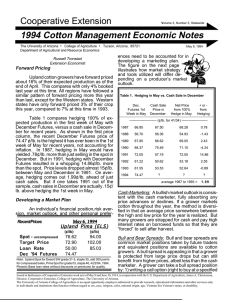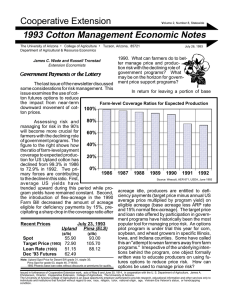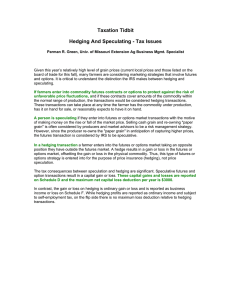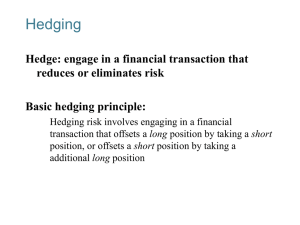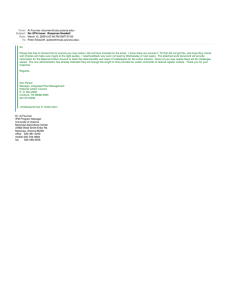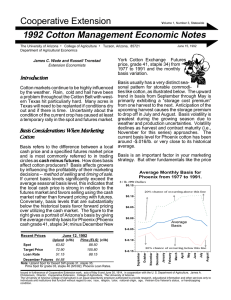1992 Cotton Management Economic Notes Cooperative Extension •
advertisement
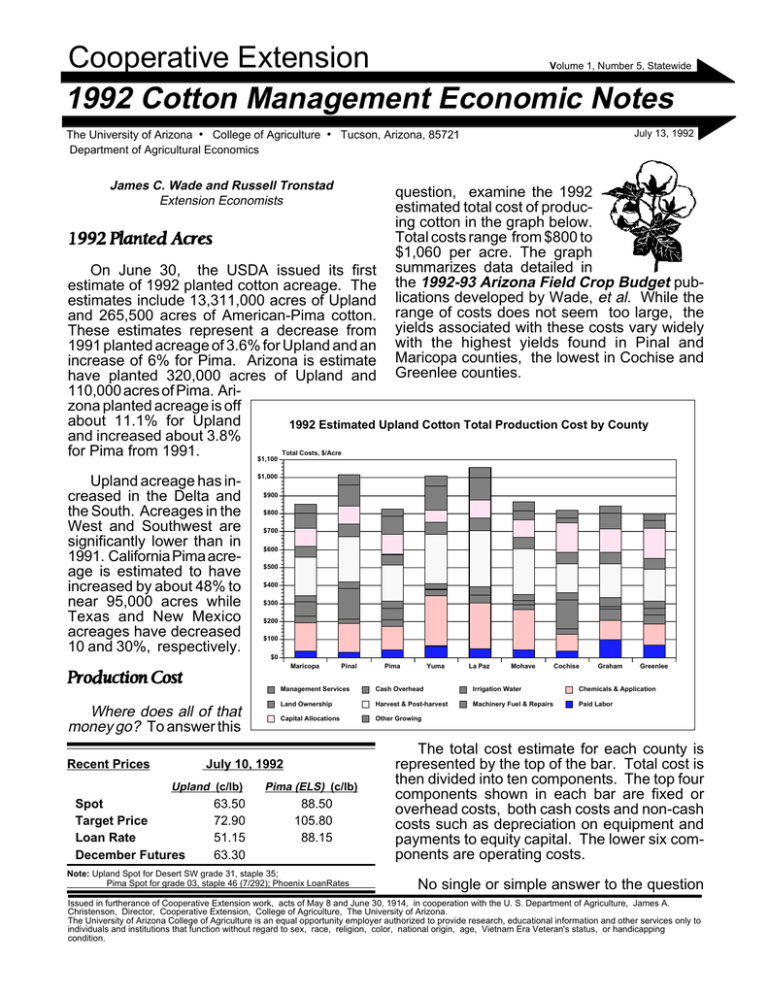
Cooperative Extension 1992 Cotton Management Economic Notes Volume 1, Number 5, Statewide July 13, 1992 The University of Arizona • College of Agriculture • Tucson, Arizona, 85721 Department of Agricultural Economics James C. Wade and Russell Tronstad Extension Economists question, examine the 1992 estimated total cost of producing cotton in the graph below. Total costs range from $800 to $1,060 per acre. The graph summarizes data detailed in the 1992-93 Arizona Field Crop Budget publications developed by Wade, et al. While the range of costs does not seem too large, the yields associated with these costs vary widely with the highest yields found in Pinal and Maricopa counties, the lowest in Cochise and Greenlee counties. 1992 Planted Acres On June 30, the USDA issued its first estimate of 1992 planted cotton acreage. The estimates include 13,311,000 acres of Upland and 265,500 acres of American-Pima cotton. These estimates represent a decrease from 1991 planted acreage of 3.6% for Upland and an increase of 6% for Pima. Arizona is estimate have planted 320,000 acres of Upland and 110,000 acres of Pima. Arizona planted acreage is off about 11.1% for Upland 1992 Estimated Upland Cotton Total Production Cost by County and increased about 3.8% Total Costs, $/Acre for Pima from 1991. $1,100 Upland acreage has increased in the Delta and the South. Acreages in the West and Southwest are significantly lower than in 1991. California Pima acreage is estimated to have increased by about 48% to near 95,000 acres while Texas and New Mexico acreages have decreased 10 and 30%, respectively. $900 $800 $700 $600 $500 $400 $300 $200 $100 $0 Production Cost Maricopa Where does all of that money go? To answer this Recent Prices $1,000 Pinal Spot Target Price Loan Rate December Futures 63.50 72.90 51.15 63.30 Yuma La Paz Mohave Cochise Graham Greenlee Management Services Cash Overhead Irrigation Water Chemicals & Application Land Ownership Harvest & Post-harvest Machinery Fuel & Repairs Paid Labor Capital Allocations Other Growing July 10, 1992 Upland (c/lb) Pima Pima (ELS) (c/lb) 88.50 105.80 88.15 Note: Upland Spot for Desert SW grade 31, staple 35; Pima Spot for grade 03, staple 46 (7/292); Phoenix LoanRates The total cost estimate for each county is represented by the top of the bar. Total cost is then divided into ten components. The top four components shown in each bar are fixed or overhead costs, both cash costs and non-cash costs such as depreciation on equipment and payments to equity capital. The lower six components are operating costs. No single or simple answer to the question Issued in furtherance of Cooperative Extension work, acts of May 8 and June 30, 1914, in cooperation with the U. S. Department of Agriculture, James A. Christenson, Director, Cooperative Extension, College of Agriculture, The University of Arizona. The University of Arizona College of Agriculture is an equal opportunity employer authorized to provide research, educational information and other services only to individuals and institutions that function without regard to sex, race, religion, color, national origin, age, Vietnam Era Veteran's status, or handicapping condition. "Where is the cost?" will do for such a diverse cotton producing state as Arizona. However, the most obvious answers are chemicals and irrigation water. Chemical cost, especially for insecticides, is major input to cotton production. Insecticide cost is also highly variable depending on the level of insect infestation and the strategies adopted by individual farmers. Water cost depends not only on the source of water but also on the irrigation technology used. Low water costs in some areas reflect the payment of water costs as assessments as a part of land ownership. Increased irrigation efficiency and decreased water cost requires capital investment and attentive management of each irrigation. Another major cost is for harvesting. Harvest costs shown in the graph are for two pickings including module building, hauling, assessments and plowdown. Harvesting is an expensive activity. Pickers are expensive to own and operate. A cost reduction strategy is pick all of the cotton in one harvest. Such a strategy would, of course, require cotton bolls to open in a uniform pattern. This strategy could also take advantage of earlier markets and possibly improve quality of the overall crop. These tradeoffs will be examined in a future newsletter. Conclusions • High yields come at high costs. • Cost control is total management. Options Versus Futures for Hedging month at a specified price (strike price) any time before the option expires, but is in no way obligated to buy. The purchaser of a put option obtains the right to sell futures at a given strike price, but is under no obligation to sell. In hedging with futures, the producer is obligated to buy back contracts previously sold or else make delivery — which is generally not a viable option for Arizona producers. In order to obtain the right to sell at the strike price, a premium is paid to the writer or seller of the put option. Thus, higher strike prices command a larger premium than lower strike prices for a put option. Hedging with options is very much like taking out an insurance policy — more benefits (i.e., higher strike price when purchasing a put) translate to a higher premium. Also, greater volatility or uncertainty in the market (i.e., primarily the cotton growing season for the Northern Hemisphere) commands a higher premium for both put and call options. An advantage to purchasing a put for hedging is that no margin monies (monies required for collateral on futures position) are required. Margin expenses are the amount of collateral required multiplied by your cost of funds or interest rate. If the market were to increase, a producer hedging with futures would incur margin expenses whereas the purchaser of a put is not obligated to exercise his option (i.e., sell at a price below the market price). Because there is no obligation to exercise an option for the purchaser, a producer can benefit from a price increase (amount of price increase less premium paid) while placing a price floor on the net price received by exercising the option if the market price decreases. In hedging with futures, a producer is unable to benefit from a price increase in the market. But no premium is required so that a futures hedge will always yield a higher net price than an option hedge (purchase of a put) when the market is declining. As discussed in the previous issue, hedging with NYCE futures allows cotton producers to “lock in a price” prior to harvest. If the general price level increases or decreases, the net price received in hedging with futures will only be affected by changes in the basis rather than the Other advantages to hedging with futures general price level. Hedging with options gives over options are that futures contracts are more producers the opportunity to benefit from an widely and heavily traded than option contracts. increasing price level, but a premium must be Option contracts are generally not offered for made to obtain a floor price in the futures market. more distant contract months and the volume of There are only two basic types of options trade is often thin for many contract months. traded, put and call options. Both put and call However, options do offer an upside price potenoptions require a writer and a purchaser. The tial and should be considered. writer and purchaser of a call option are not Most importantly, futures and option informadirectly related to a put option and vice versa. tion can be utilized as a valuable source of Put and call options are both separate contracts. market information for making planting and cash The purchaser of a call option obtains the marketing decisions, even if they are not utilized right to buy futures for a specified contract as a hedging tool. Disclaimer: Neither the issuing individuals, originating unit, Arizona Cooperative Extension, nor the Arizona Board of Regents warrant or guarantee the use or results of this publication issued by the Arizona Cooperative Extension and its cooperating Departments and Offices.
